
Ulmus wallichianaPlanch., the Himalayan elm, also known as the Kashmir elm and Bhutan elm, is a mountain tree ranging from central Nuristan in Afghanistan, through northern Pakistan and northern India to western Nepal at elevations of 800–3000 m. Although dissimilar in appearance, its common name is occasionally used in error for the cherry bark elm Ulmus villosa, which is also endemic to the Kashmir, but inhabits the valleys, not the mountain slopes. The species is closely related to the wych elm U. glabra.

Ulmus davidiana var. japonica, the Japanese elm, is one of the larger and more graceful Asiatic elms, endemic to much of continental northeast Asia and Japan, where it grows in swamp forest on young alluvial soils, although much of this habitat has now been lost to intensive rice cultivation.
Ulmus bergmannianaC.K.Schneid., commonly known as Bergmann's elm, is a deciduous tree found across much of China in forests at elevations of 1500–3000 m.

Ulmus laciniata(Trautv.) Mayr, known variously as the Manchurian, cut-leaf, or lobed elm, is a deciduous tree native to the humid ravine forests of Japan, Korea, northern China, eastern Siberia and Sakhalin, growing alongside Cercidiphyllum japonicum, Aesculus turbinata, and Pterocarya rhoifolia, at elevations of 700–2200 m, though sometimes lower in more northern latitudes, notably in Hokkaido.
Ulmus chumlia is a small deciduous tree endemic to the Himalaya from the Kashmir to central Nepal, and the provinces of Yunnan, Sichuan and Xizang (Tibet) in China. It is found in broadleaf forest on mountain slopes at elevations of 1000–3000 m. Richens noted that the species appeared to be the same as that named by Grudzinskaya as Ulmus androssowii var. virgata, which she considered an intermediate between U. minor and U. pumila.

Ulmus lanceifoliaRoxburgh, ex Wall., occasionally known as the Vietnam elm, is a very large tree endemic to a wide area of southern Asia. Its range extends southeast and eastwards from Darjeeling in the Himalaya, through Bangladesh, southern China, Myanmar, Thailand, Laos, Vietnam and on discontinuously into Indonesia, straddling the Equator in Sumatra and Celebes.
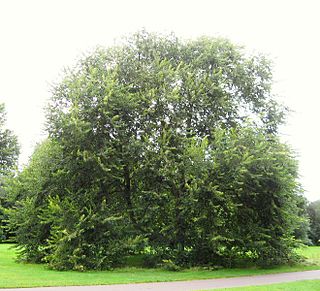
Ulmus villosa, the cherry-bark elm or Marn elm, is one of the more distinctive Asiatic elms, and a species capable of remarkable longevity. It is endemic to the valleys of the Kashmir at altitudes of 1,200–2,500 metres but has become increasingly rare owing to its popularity as cattle fodder. Mature trees are now largely restricted to temples and shrines where they are treated as sacred. Some of these trees are believed to be over 800 years old.
Ulmus × brandisianaMelville & Heybroek is a naturally occurring elm hybrid found across the Kashmir region, arising from the crossing of Ulmus chumlia and the Himalayan elm, Ulmus wallichiana. The hybrid was formally recognized by Melville and Heybroek after the latter's expedition there in 1960.
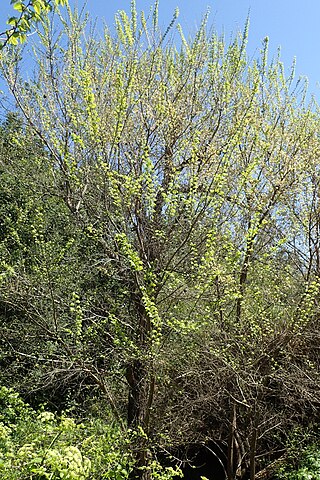
Ulmus minorsubsp.canescens is a small deciduous tree occasionally known by the common names grey elm, grey-leafed elm, and hoary elm. Its natural range extends through the lands of the central and eastern Mediterranean, from southern Italy, the islands of Sicily, Malta, Crete, Rhodes and Cyprus, and through Thrace to Turkey, and as far south as Israel, where it is now considered rare and endangered in the wild. The tree is typically found amidst the comparatively humid coastal woodlands and scrublands.
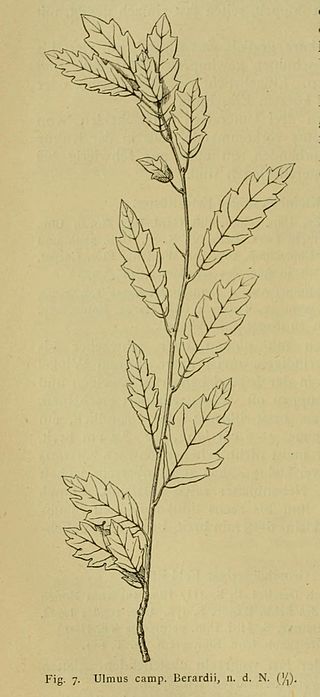
The elm cultivar Ulmus 'Berardii', Berard's Elm, was raised in 1865, as Ulmus Berardi, from seeds collected from large specimens of "common elm" growing on the ramparts at Metz, by an employee of the Simon-Louis nursery named Bérard. Carrière (1887), the Späth nursery of Berlin and the Van Houtte nursery of Gentbrugge regarded it as form of a Field Elm, listing it as U. campestris Berardii, the name used by Henry. Cheal's nursery of Crawley distributed it as Ulmus nitens [:Ulmus minor] 'Berardii'. Smith's of Worcester preferred the original, non-specific name, Ulmus 'Berardii'.
The Field Elm cultivar Ulmus minor 'Cucullata', the Hooded elm, was listed by Loddiges of Hackney, London, in their catalogue of 1823 as Ulmus campestris cucullata, and later by Loudon in Arboretum et Fruticetum Britannicum (1838), as U. campestris var. cucullata.

The hybrid elm cultivar Ulmus × hollandica 'Superba' is one of a number of intermediate forms arising from the crossing of the Wych Elm U. glabra with a variety of Field Elm U. minor. Boulger tentatively (1881) and Green more confidently (1964) equated it with a hybrid elm cultivated in the UK by Masters at Canterbury in the early 19th century, known as "Masters' Canterbury Seedling" or simply the Canterbury Elm. Loudon examined a specimen sent by Masters and considered it a hybrid, calling it U. montana glabra major.
Ulmus wallichiana subsp. wallichiana was identified by Melville and Heybroek after the latter's expedition to the Himalaya in 1960.
Ulmus wallichiana var. tomentosa was identified by Melville & Heybroek after the latter's expedition to the Himalaya in 1960.
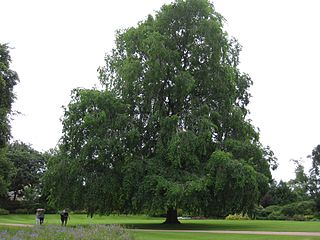
Ulmus × hollandica 'Wentworthii Pendula', commonly known as the Wentworth Elm or Wentworth Weeping Elm, is a cultivar with a distinctive weeping habit that appears to have been introduced to cultivation towards the end of the 19th century. The tree is not mentioned in either Elwes and Henry's or Bean's classic works on British trees. The earliest known references are Dutch and German, the first by de Vos in Handboek tot de praktische kennis der voornaamste boomen (1890). At about the same time, the tree was offered for sale by the Späth nursery of Berlin as Ulmus Wentworthi pendulaHort.. The 'Hort.' in Späth's 1890 catalogue, without his customary label "new", confirms that the tree was by then in nurseries as a horticultural elm. De Vos, writing in 1889, states that the Supplement to Volume 1 includes entries announced since the main volume in 1887, putting the date of introduction between 1887 and 1889.

The Field Elm cultivar Ulmus minor 'Goodyeri', commonly known as 'Goodyer's Elm', was discovered by John Goodyer in 1624 at Pennington near the Hampshire coast between Lymington and Christchurch. No old specimens are known to survive, but the tree is perpetuated by numerous root suckers, notably in the lanes about the Alice Lisle public house in the New Forest hamlet of Rockford. The tree has suffered misidentification in the centuries since its discovery, firstly by Philip Miller in his 'Gardeners' Dictionary' of 1731, and later in the early 20th century by Augustine Henry and Marcus Woodward, who both confused the tree with Plot Elm, whose centre of distribution is in the East Midlands, some 200 miles away and of completely different appearance.
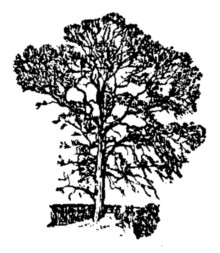
Ulmus × diversifolia, also known as the diverse leaved elm, was originally described by Melville in 1939 as a new species, U. diversifolia, though he later believed it a natural hybrid of Coritanian elm, Plot elm and Wych elm. He recorded its distribution in Hertfordshire, between Hatfield, Hertford and Watton-at-Stone, and in Suffolk, where it was common along the coastal plain from Ipswich and Felixstowe to Lowestoft and Beccles, occurring inland as far as Diss and Debenham, and probably extending further north into Norfolk and south towards Colchester, Essex. He accordingly referred to it as "the East Anglian elm".
The Field Elm cultivar Ulmus minor 'Viminalis Betulaefolia' (:'birch-leaved') is an elm tree of uncertain origin. An U. betulaefolia was listed by Loddiges of Hackney, London, in the catalogue of 1836, an U. campestris var. betulaefolia by Loudon in Arboretum et Fruticetum Britannicum (1838), and an U. betulifoliaBooth by the Lawson nursery of Edinburgh. Henry described an U. campestris var. betulaefolia at Kew in 1913, obtained from Fulham nurseryman Osborne in 1879, as "scarcely different from var. viminalis ". Melville considered the tree so named at Kew a form of his U. × viminalis, while Bean (1988), describing U. 'Betulaefolia', likewise placed it under U. 'Viminalis' as an apparently allied tree. Loudon and Browne had noted that some forms of 'Viminalis' can be mistaken for a variety of birch. An U. campestris betulaefolia was distributed by Hesse's Nurseries, Weener, Germany, in the 1930s.
The Field Elm cultivar Ulmus minor 'Glandulosa' was described as Ulmus glabra [:smooth-leaved] Mill. var. glandulosa by Lindley in A Synopsis of British Flora, arranged according to the Natural Order (1829), from trees near Ludlow, Shropshire. Melville identified a specimen in Ludlow in 1939, calling it in a 1946 paper "a good form of U. carpinifolia" [:U. minor ], describing it more fully and renaming it U. carpinifoliaGled. var. glandulosa (Lindl.). Regarding it as out of its natural range and deliberately planted, he referred to it as The Ludlow Elm, the "type tree" of a "variety" of Field Elm. Herbarium specimens of 'Glandulosa' are held in both the Lindley Herbarium in Cambridge and the Borrer Herbarium at Kew.













